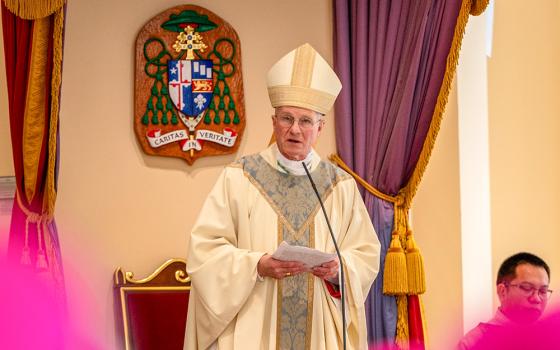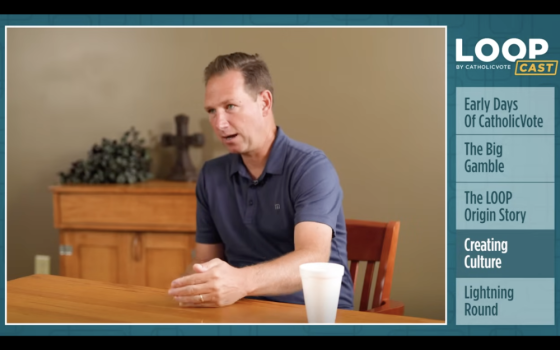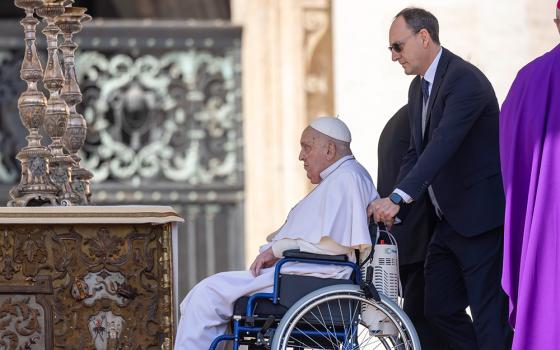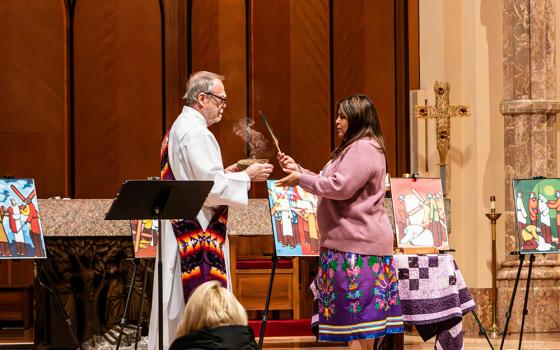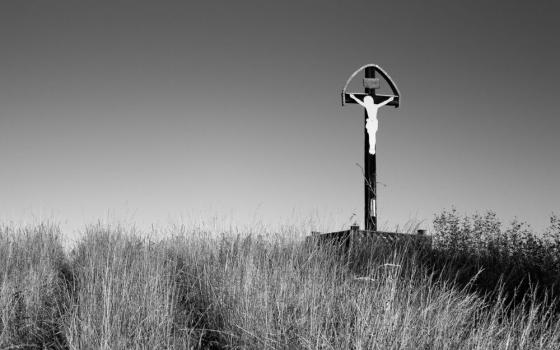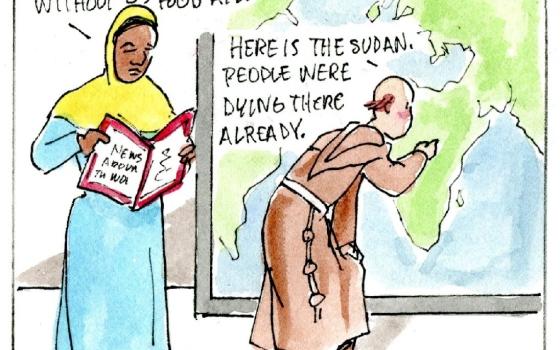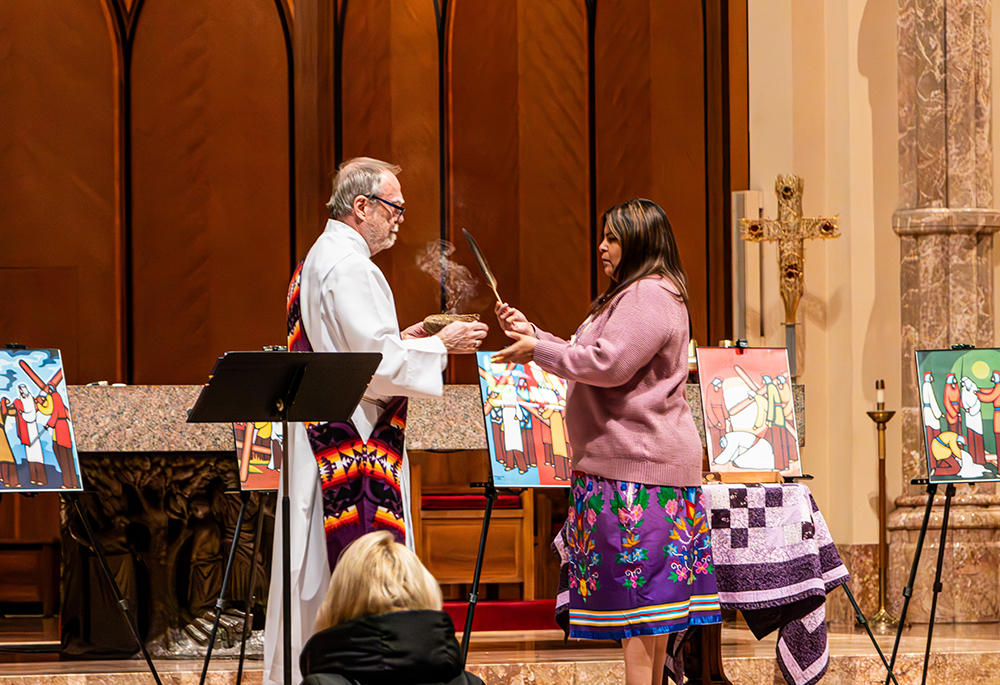
Deacon Bill Frere and Jody Roy, both of the St. Kateri Center of Chicago, conduct a smudging ceremony with an eagle feather and sage in Holy Name Cathedral in Chicago, prior to an April 11 Stations of the Cross centered on Native Americans. The devotion's prayers, composed by a permanent deacon with Indigenous ancestry, meditate on the suffering of Native people while calling for the faithful to stand in solidarity and work for justice. (Courtesy of Jade Roy)
Jody Roy remembers hearing how her aunt was removed from the family home as a child and taken to a Jesuit-run residential school years ago. The girl's long hair was cut, Native clothing discarded and Ojibwe language banned.
"My mom's older siblings were all taken, and they experienced abuse on different levels; some were sexually abused, for others it was mental abuse," said Roy, a member of the Ojibwe Tribe. "For all of them it was horrific."
This Lent, a new version of an old Catholic devotion seeks to acknowledge the traumas experienced by Native people, including those inflicted by the Catholic Church, and to offer spiritual reflections on both suffering and healing.
"Stations of the Cross: A Native American Catholic Journey of Healing and Reconciliation" was written by a Catholic deacon with Indigenous ancestry and is the first set of stations to incorporate themes from the U.S. bishops' guidelines for ministering to Indigenous Catholics in the United States.

Jody Roy, member of the Ojibwe Tribe, and Deacon Bill Frere lead the stations in Holy Name Cathedral in Chicago. Prayers for the devotion were drawn from the U.S. bishops' document on pastoral ministry to Indigenous Catholics, which was approved in June 2024. (Courtesy of Jade Roy)
Approved at the prelates' 2024 spring assembly, the pastoral framework covers topics from the sacraments and family life to the intergenerational wounds borne by Native people. It also includes a brief apology for the church's contribution to those wounds, especially through the operation of boarding schools.
In recent years Catholics have used the 14 stations, which begin with Jesus' condemnation and end with his placement in a tomb, to meditate on care for creation, racism, and the struggles of refugees and immigrants.
The practice of coupling the devotion with a variety of social concerns likely emerged around the 1990s but may have origins in the Catholic Worker moment, according to Colt Anderson, a church historian and theologian at Fordham University in New York. Anderson said Dorothy Day, an intellectual, journalist, pacifist and founder of the movement, promoted the stations and would connect the plight of the working class and poor to the cross.
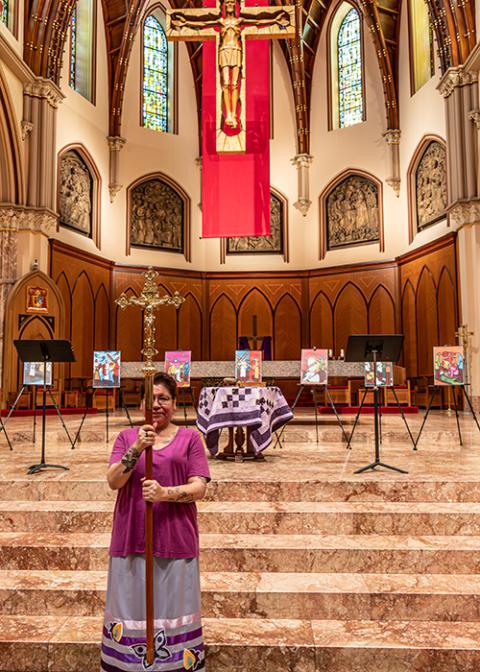
Toni Schunk, a member of the Mandan, Hidatsa and Arikara Nation, holds the crucifix during "Stations of the Cross: A Native American Catholic Journey of Healing and Reconciliation" at Holy Name Cathedral in Chicago. (Courtesy of Jody Roy)
"There is a natural link between the suffering of Christ and the suffering of various people," said Anderson, adding that it is not uncommon for Catholic devotions to evolve over time.
Roy serves as director of St. Kateri Center of Chicago and organized an April 11 recitation of the new Native American stations in the city's Holy Name Cathedral.
"I was wowed by the prayers and drawn to them immediately, especially because it is a challenging time for Native American Catholics," said Roy, pointing to recent reports about the extent of abuse at church-run boarding schools in the United States and the possibility of unmarked graves in Canada.
Larry Deschaine, a permanent deacon in the Diocese of Charleston, South Carolina, said he wanted to write a Stations of the Cross that incorporated traditional Catholic devotion with Indigenous perspectives on creation, community and spirituality.
"I hoped to create a pathway toward healing that neither erases painful history nor remains trapped in it," he told the National Catholic Reporter.
Deschaine's prayers include terms and images used by some Native people, such as referring to "Creator God, Great Spirit," and draw parallels between the agony of Jesus and Indigenous communities. They call for action in addition to contemplation.
"The death of Jesus," reads one reflection, "carries echoes of the many deaths that have marked Native history — the mass killings at Wounded Knee and other massacre sites, the countless children who never returned from boarding schools, the elders who died with languages and knowledge that disappeared with them."
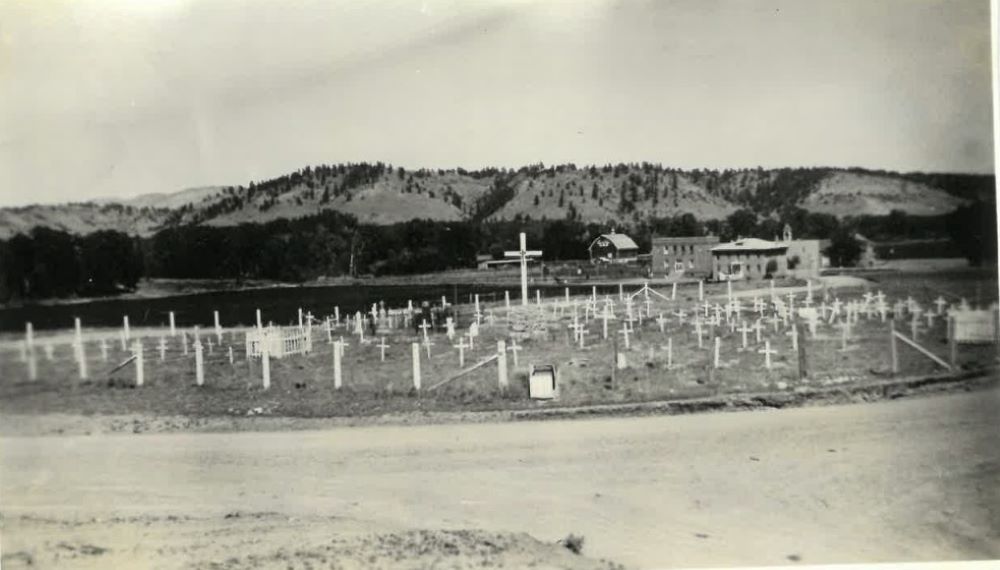
St. Labre Cemetery is pictured around 1930. A 16-month investigation found no evidence of unmarked graves but determined at least 113 students died while enrolled at the St. Labre boarding schools in Montana. (Courtesy of St. Labre Indian School Archives)
Another prayer reads: "Help us to practice true solidarity that goes beyond words to concrete actions for justice."
Some former students of U.S. and Canadian schools for Indigenous youths recall positive academic and social experiences, while many recount unsanitary environments and a range of abuse. Indigenous leaders have described the schools' mission of assimilation as cultural genocide.
Deschaine is on the board of the U.S. Catholic Indigenous Boarding Schools Accountability and Healing Project and was one of the Native American Catholics to assist with the U.S. bishops' "Keeping Christ's Sacred Promise: A Pastoral Framework for Indigenous Ministry," which received strong support from the bishops at their gathering last June.
Approximately 20% of Native Americans in the United States identify as Catholic, and more than 340 parishes serve predominantly Native congregations, according to the U.S. Conference of Catholic Bishops.
Advertisement
Native American Catholics do not need to feel torn between their culture and their faith, asserts the wide-ranging pastoral framework. "Your cultural embodiment of the faith is a gift to the Church," it states.
The bishops also write that the Catholic Church recognizes it has "played a part in traumas experienced by Native children," and they apologize "for the failure to nurture, strengthen, honor, recognize, and appreciate those entrusted to our pastoral care."
Reactions to the apology were mixed. Some Indigenous individuals praised it as historic progress, others viewed it as patently inadequate. It was criticized for its silence on the documented sexual abuse of children at boarding schools.
Roy said it was an important step. "It's an acknowledgement in the beginning stages," she said.
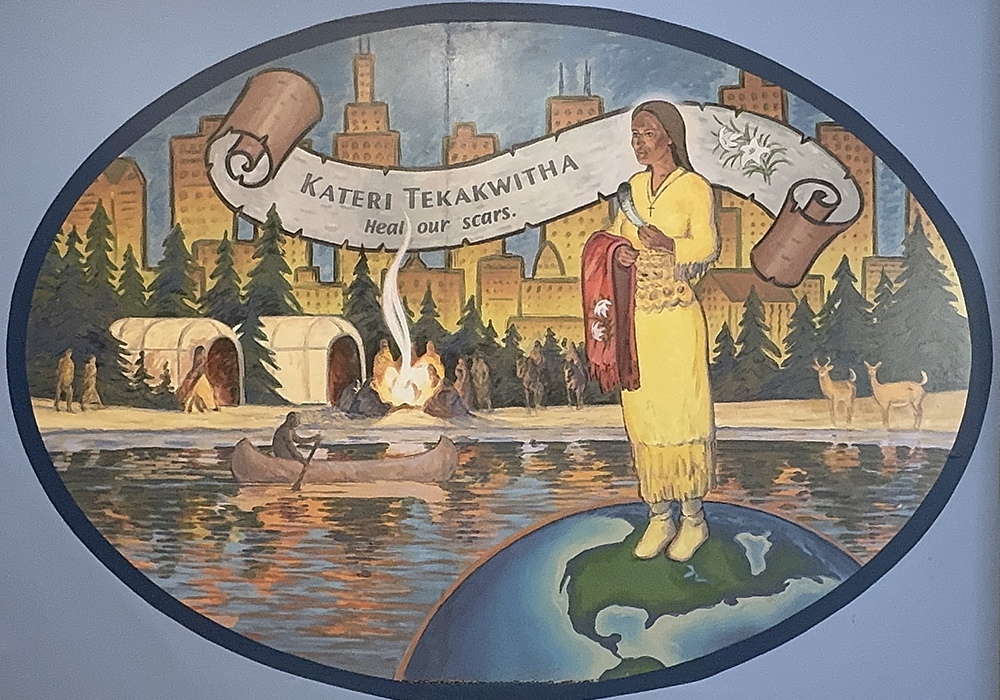
A mural of Kateri Tekakwitha, the first Indigenous North American saint, hangs in the St. Kateri Center of Chicago. In the background of the painting, created by Paul Noah, are the Chicago skyline and images depicting the Great Lakes region tribes. Though Native American families have long known about the trauma of forced assimilation, new reports have "woken up all our hearts and pains," said Jody Roy, center director. (Courtesy of Jody Roy)
Woven into Deschaine's version of the stations are stories of saints, including Kateri Tekakwitha, the first Indigenous North American saint to be canonized. There are also quotations from Pope Francis' documents, among them his landmark encyclical on ecology, "Laudato Si', on Care for Our Common Home," and Querida Amazonia ("Beloved Amazon"), focused on the harm caused by unrestrained development in the South American region.
Fr. Michael Carson, assistant director of Native American affairs for the U.S. bishops' Secretariat for Cultural Diversity in the Church, shared the Stations of the Cross with his network of Native American leaders and those who minister among Indigenous communities. The prayers are available for any group or individual to use.
"Reconciliation is an ongoing journey, and the stations that Deacon Deschaine adapted reminds us of this," Carson said in an email to NCR.
Though Native American families have long known about the trauma of boarding schools and forced assimilation, the new reports and investigations have "woken up all our hearts and pains," Roy said. "But I'm glad it is coming out because ultimately for our people to heal, our truth has to be told."
Roy said she knows fellow Native individuals who will never forgive the Catholic Church. "That is OK and I understand it," she said. "But I hope to help put the truth out there and to help that healing journey for our people, as well as educate and challenge those who did not know this history."
This Stations of the Cross, she said, is "a beautiful way to do that through prayer."

